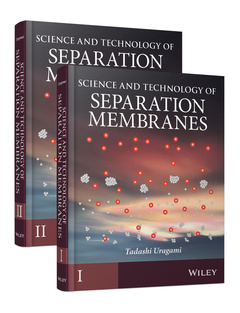Science and Technology of Separation Membranes, 2 Volume Set 2 Volume Set
Coordonnateur : Uragami Tadashi

- Written by a renowned author with more than 40 years? experience in membrane science and technology, and polymer science
- Covers all major current applications of membrane technology in two definitive volumes
- Includes academic analyses, applications and practical problems for each existing membrane technology
- Includes novel applications such as membrane reactors, hybrid systems and optical resolution as well as membrane fuel cells
Preface xix
Acknowledgements xxiii
Volume I
1 Introduction to Membrane Science and Technology 1
1.1 History of Membrane Science and Technology 1
1.2 Membrane Module 6
1.3 Necessity of Membrane Science and Technology 7
References 8
2 Membrane Structure 13
2.1 Structural Design of Membranes 13
2.2 Symmetric Non-porous and Porous Membranes 14
2.3 Asymmetric and Composite Membranes 15
2.4 Relation between Structure and Preparation Condition of Membrane 16
2.5 Structure of Liquid Membranes 50
2.6 Structure of Inorganic Membranes 53
References 53
3 Preparation Methods of Membranes 59
3.1 Polymer Membranes 59
3.2 Inorganic Membranes 74
3.3 Organic–Inorganic Hybrid Membranes 75
3.4 Liquid Membranes 76
References 80
4 Membrane Shapes and Modules 87
4.1 Membrane Shapes 87
4.2 Membrane Module 94
References 102
5 Characterization of Membrane 105
5.1 Methods and Subjects of Evaluation 105
References 142
6 Fundamentals of Membrane Transport Phenomena 147
6.1 Thermodynamical Fundamentals for Membrane Transport 147
6.2 Solution-Diffusion Model 166
6.3 Pore Flow 171
References 177
7 Phenomena during Membrane Permeation and Separation 181
7.1 Concentration Polarization 181
7.2 Membrane Fouling 197
References 199
8 Dialysis 205
8.1 Diffusion Dialysis 205
8.2 Donnan Dialysis 224
8.3 Neutralization Dialysis 226
8.4 Piezodialysis 228
8.5 Electrodialysis 233
8.6 Technologies of Electrodialysis 237
8.7 Electrodialysis with Bipolar Membranes 244
References 251
9 Reverse Osmosis 259
9.1 Principle of Reverse Osmosis 259
9.2 Fundamental Analysis of Reverse Osmosis 259
9.3 Materials and Structures of Reverse Osmosis Membranes 266
9.4 Concentration Polarization and Fouling 270
9.5 Technologies and Applications of Reverse Osmosis 274
9.6 Membrane Module of Reverse Osmosis 289
9.7 Membrane Cleaning 291
References 292
10 Nanofiltration 297
10.1 Principle of Nanofiltration 297
10.2 Fundamental Analysis of Nanofiltration 297
10.3 Membranes and Modules for Nanofiltration 300
10.4 Concentration Polarization and Membrane Fouling in Nanofiltration 308
10.5 Technology 311
References 318
11 Ultrafiltration 325
11.1 Principle of Ultrafiltration 325
11.2 Fundamental Analysis of Ultrafiltration 325
11.3 Membranes for Ultrafiltration 333
11.4 Ultrafiltration Modes 333
11.5 Concentration Polarization and Fouling in Ultrafiltration 335
11.6 Ultrafiltration Technology 342
11.7 Ultrafiltration Applications 343
References 355
12 Microfiltration 359
12.1 Principle of Microfiltration 359
12.2 Fundamental Analysis of Microfiltration 360
12.3 Membranes for Microfiltration 363
12.4 Fouling in Microfiltration 365
12.5 Module of Microfiltration 368
12.6 Microfiltration Technology 368
References 375
13 Comparison of Pressure-Driven Membrane Separation Processes 379
13.1 Pressure-Driven Membrane Separation Technologies 379
13.2 Problems of Reverse Osmosis and Nanofiltration 382
References 383
Volume II
14 Forward Osmosis 385
14.1 Principle of Forward Osmosis 385
14.2 Advantages and Problems of Forward Osmosis 385
14.3 Fundamental Analysis of Forward Osmosis 387
14.4 Membranes and Modules for Forward Osmosis 387
14.5 Technology 391
14.6 Application Area of Forward Osmosis Process 391
14.7 Improvement of Forward Osmosis Membrane Performance 401
14.8 Fouling in Forward Osmosis 406
References 408
15 Pervaporation 413
15.1 Principle of Pervaporation 413
15.2 Fundamental Analysis of Pervaporation 414
15.3 Membranes for Pervaporation 417
15.4 Technologies 428
References 461
16 Evapomeation 471
16.1 Principle of Evapomeation 471
16.2 Membranes of Evapomeation 472
16.3 Technology of Evapomeation 475
References 502
17 Temperature-Difference Controlled Evapomeation 509
17.1 Principle of Temperature-Difference Controlled Evapomeation 509
17.2 Membranes of Temperature-Difference Controlled Evapomeation 509
17.3 Technology of Temperature-Difference Controlled Evapomeation 510
References 533
18 Membrane Distillation 535
18.1 Principle of Membrane Distillation 535
18.2 Fundamental Analysis of Membrane Distillation 537
18.3 Membranes of Membrane Distillation 541
18.4 Technologies of Membrane Distillation 546
References 553
19 Gas Permeation 559
19.1 Beginning of Gas Permeation 559
19.2 Fundamentals of Gas Permeation 560
19.3 Membranes for Gas Permeation 567
19.4 Membranes from Inorganic Materials 575
19.5 Modules of Gas Separation Membrane 577
19.6 Technology of Gas Permeation Membrane 577
References 583
20 Carrier Transport 587
20.1 Fundamental Principle of Carrier Transport through Artificial Membranes 587
20.2 Carriers in Membrane Transport 591
20.3 Technology of Carrier Transport Membranes 596
References 629
21 Membrane Reactor 635
21.1 Concept of Membrane Reactors 635
21.2 Membranes for Membrane Reactors 635
21.3 Technology of Membrane Reactors 640
References 661
22 Membrane Contactors 667
22.1 Principle and Fundamentals of Membrane Contactors 667
22.2 Membranes for Membrane Contactors 669
22.3 Technology of Membrane Contactors 672
References 676
23 Fuel Cell Membranes 679
23.1 Principles of the Fuel Cell 679
23.2 Good Points of Fuel Cells 680
23.3 Membranes for Fuel Cells 681
23.4 Technology of Fuel Cells 682
References 691
24 Hybrid Systems of the Membrane Separation Process 695
24.1 Hybrid Systems of Membrane Technology and Reactive Production Step, Other Separation Technology 695
24.2 Hybrid Systems with Plural Membrane Technology 705
References 713
25 Optical Resolution by Membranes 717
25.1 Present Conditions and Problem of Optical Resolution with Membranes 717
25.2 Membranes for Optical Resolution 718
25.3 Technology of Optical Resolution Membranes 721
References 730
26 Material Separations by Other Membrane Processes 735
26.1 Carbon Nanotube Membranes 735
26.2 Graphene Membranes 736
26.3 Technologies of Carbon Nanotube and Graphene Membranes 738
References 760
27 Conclusions and Prospects for the Future 769
Reference 771
Index 773
Tadashi Uragami, Functional Separation Membrane Research Center, Japan
Date de parution : 04-2017
Ouvrage de 848 p.
19.6x25.4 cm


